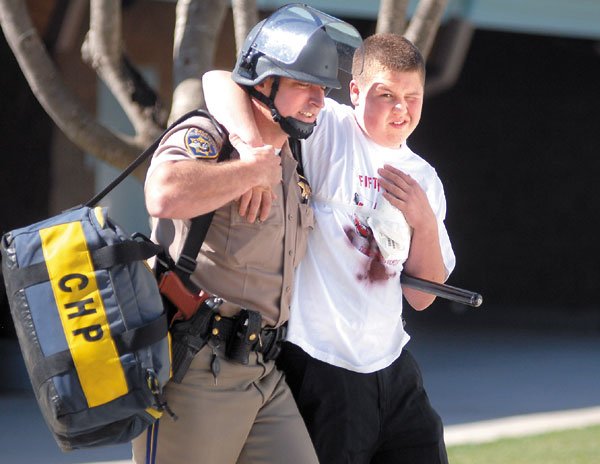Gilroy
– It’s a parent’s worst nightmare: An armed gunman terrorizing a
school. Thankfully, police responded to an imaginary threat, not a
real one, when they shut down Gilroy High School on Friday.
Gilroy – It’s a parent’s worst nightmare: An armed gunman terrorizing a school.
Thankfully, police responded to an imaginary threat, not a real one, when they shut down Gilroy High School on Friday. It took 90 minutes to capture the bad guy, as played by Cpl. Justin Matsuhara, but police said the practice drill proved that when school threats strike, Gilroy is ready.
“We learned some things,” said School Resource Officer Cherie Somavia, “but that’s the purpose.”
Police declined to allow a reporter to listen to a post-drill debriefing, but said the response was acceptable.
“We’re comfortable that if this were real, we could handle it,” said Gilroy Police Sgt. Joseph Deras.
The “Code Red” drill took on a scary premise: A crazed man with a handgun, storming the campus and threatening to shoot his wife and teen child. When Gilroy police arrived, brandishing plastic guns, they circled the campus, seeking their suspect. Two teens lay spattered with fake blood at opposite ends of the campus. One was playing dead; the other, playing injured.
Three teams of Gilroy officers, Sheriff’s deputies and Highway Patrol officers combed the sprawling school, and rescued the injured teen, played by volunteer Mark Jacobsen, roughly 30 minutes after alarms sounded. To replicate a real threat, Somavia staged the bodies and a suspicious backpack, and coordinated teen volunteers to flee a campus portable, where Matsuhara was pretending to hold them hostage.
A few minor flubs marred the drill. At first, the campus alarm didn’t sound, said Assistant Principal Greg Camacho-Light. Fortunately, the error took less than a minute to fix. A handful of the school’s 90-plus classrooms didn’t respond properly to a campus notification system, which forced officers to check each nonresponsive room: Camacho-Light said some teachers needed more training in the system.
Officers from the three different agencies found it difficult to communicate, because each agency has its own radio frequency, Somavia said. Still, said CHP Sgt. Dave Hill, “we were right there to tell each other … Deras and I could hear each other’s radios.”
Because the event was a drill, officers faced some additional limitations, Deras said. In a real-life emergency, Special Weapons And Tactics teams and a helicopter would likely assist, and officers could force open doors and break windows. When police surrounded Matsuhara in a single locked portable, they heard muffled shouts of “Help!” from the room, but had to wait for a second strike team and a key to get in. In the end, the key proved unnecessary: Matsuhara stepped out of the portable just before noon and surrendered, then joked, “I was getting hungry for lunch.”
Friday’s event was the first Code Red drill at GHS since last spring, and the first to sound off between, instead of during, classes.
“We wanted to get closer to the real thing,” explained Camacho-Light.
The drill was a test for students and teachers, too. Classes halted during the drill, and students barricaded themselves into classrooms. Most students were accompanied by a teacher, but one group, bolting into an empty room, handled the drill themselves.
Camacho-Light said he expects a handful of referrals to follow the drill, the result of stir-crazy classroom shenanigans, but was generally impressed by the students’ quick and serious response.
Following Friday’s drill, officers debriefed in a 15-minute session in the parking lot.
“It’s not a finger-pointing session,” said Deras. “We treat it as a learning experience … There’s always room for improvement.”
Camacho-Light echoed his comments.
“There’s a lot more we can do,” he said, “but if it’s real, we’ll be doing very well.”














